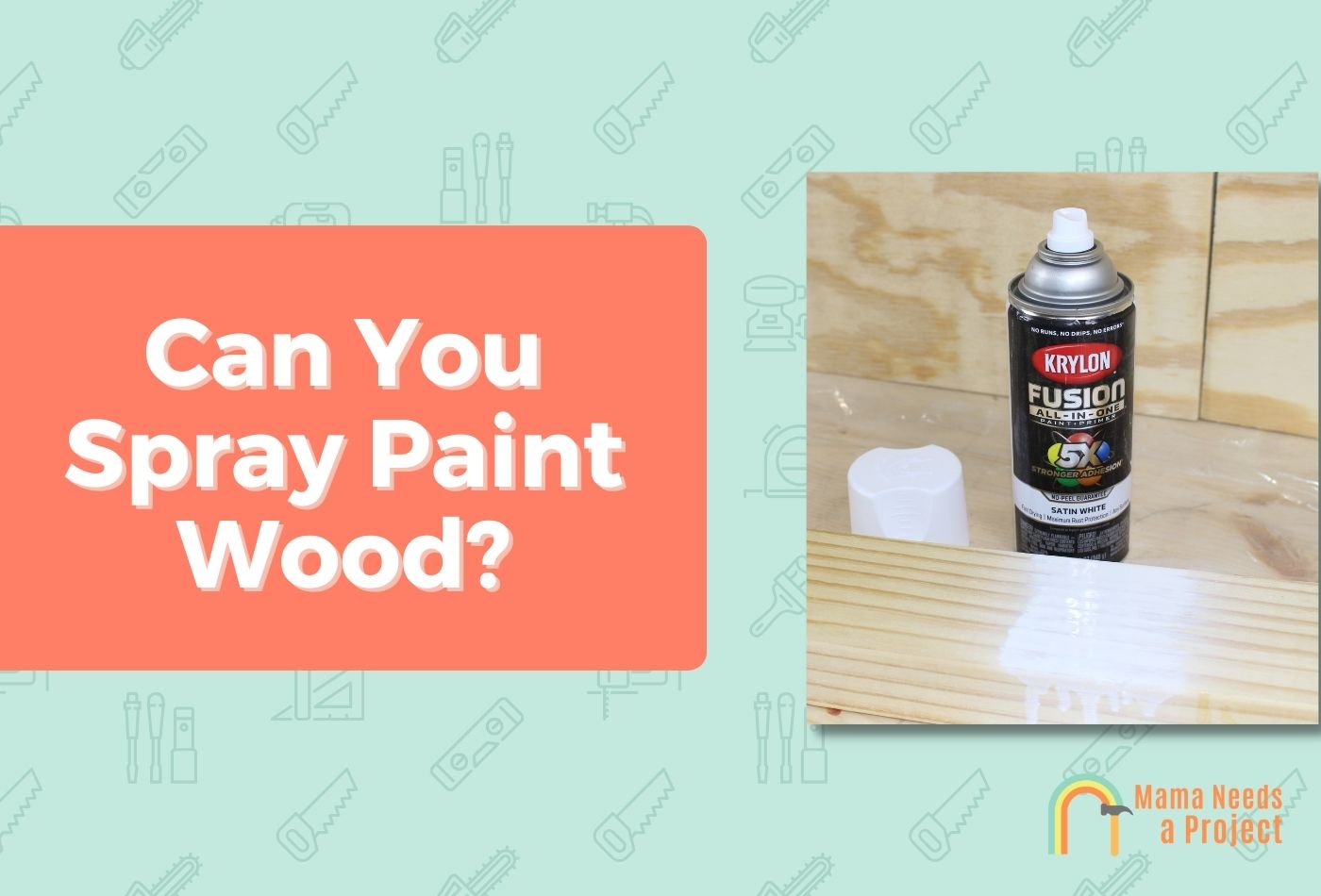Can You Spray Paint Wood? What to Know (2024)
Whether you’re painting furniture, cabinets, or another wood surface, you might be tempted to bring out a can of spray paint to give your project a new look. After all, spray painting is fast and easy, right?
But can you spray paint wood? Let’s find out!
Yes, you can spray paint wood under the right circumstances. You’ll want to be sure to prep the wood first to ensure the paint sticks to the wood.
Does Spray Paint Stick to Wood?
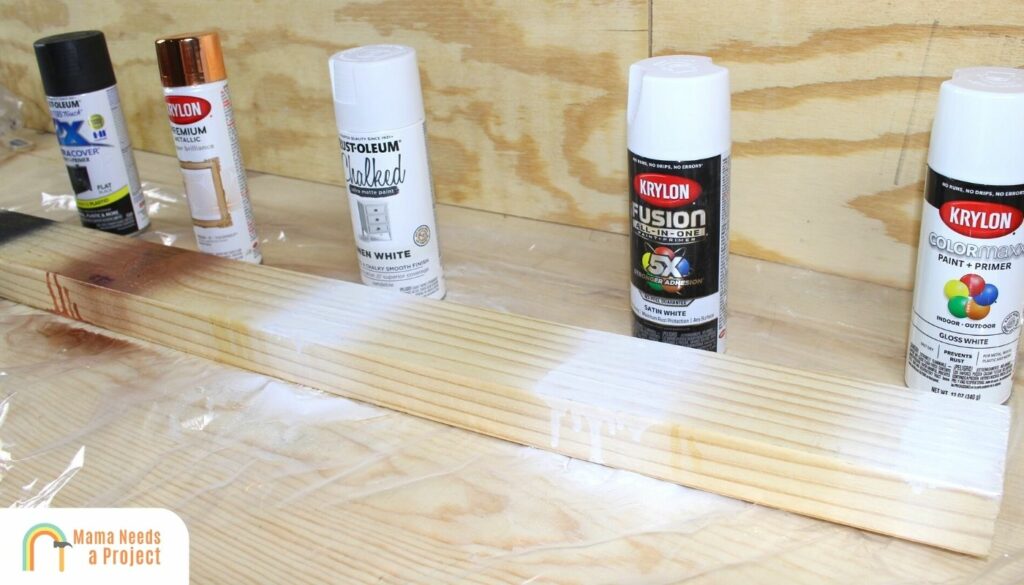
Spray paint, when applied properly, will stick to wood.
Therefore, you can use many different types of spray paint to color or decorate wooden surfaces, like tables, doors, walls, signs, and much more.
Wood is by nature a porous and absorbent material, especially bare wood. Therefore, if you apply spray paint to some wood surfaces, you might find that most of the paint gets absorbed into the wood and doesn’t apply properly.
If you want to spray paint wood, you need to prepare it ahead of time, and you need to use the right spray paint and materials for the job.
Check out my guide to learn if spray paint is waterproof and how to use it on wood!
The Type of Spray Paint Matters
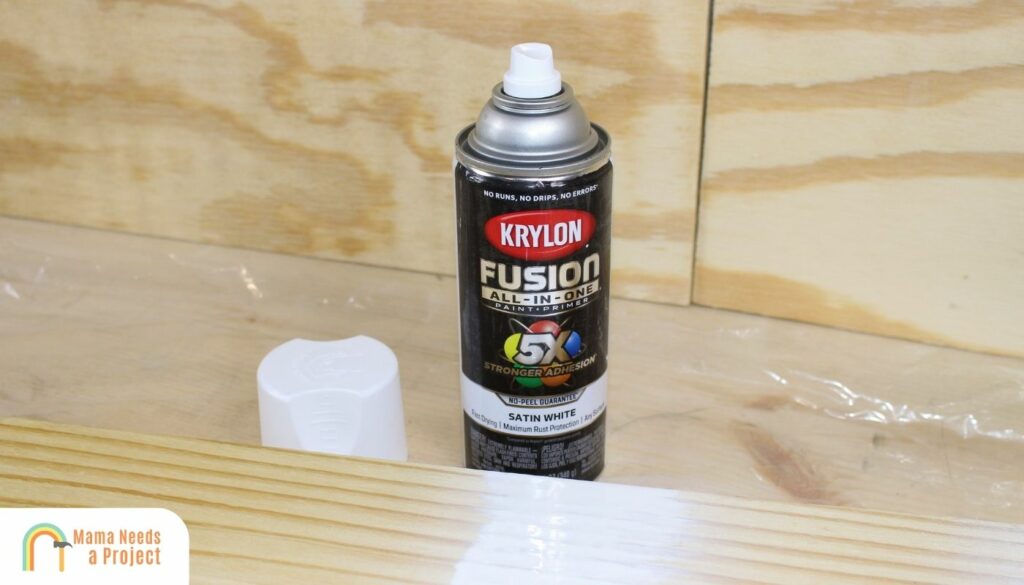
There are a few different types of spray paint you can apply to wooden surfaces. In fact, there are dozens of different colors, finishes, and spray paint brands to choose from. But the most important thing to focus on is whether the paint is water-based or oil-based.
Water-Based Spray Paint
Water-based spray paint contains a very low level of compounds and harmful paint chemicals. As a result, water-based spray paints are the best choice for spray painting wood furniture or other surfaces. They are less likely to damage, stain, or discolor a wooden surface.
On top of that, water-based spray paints are advantageous for several reasons:
- They don’t require any special prep work. Considering the fact that you have to prepare wood surfaces for spray paint (see more below), this can cut down on time you spend spray painting and give you more time to accomplish other tasks
- They are very easy to use. Practically anyone can take a water-based spray paint and apply it in a matter of minutes
- They drive very quickly. Water-based spray paints dry in less than two hours per coat (i.e., one coat will dry in two hours, while two coats of water-based spray paint may dry in 3 to 4 hours). Thanks to this, water-based spray paint is perfect for re-coating, sanding, and sealing the finish of your wood surface.
- They perform well on a variety of wood surfaces and textures. Due to their material composition, water-based spray paint penetrates wood grains very quickly and easily yielding a great finish.
If you’re looking to pray paint wood, I would recommend using water-based spray paint.
Solvent/Oil-Based Spray Paint
However, you don’t always have to use water-based spray paint. In some instances, it might be beneficial to use an oil based spray paint for your project.
For example, any wood surface that will be outdoors or in a high moisture environment should be sealed with an oil-based paint. This is because water-based spray paints are not as resistant to moisture and humidity as oil-based paints.
Oil-based spray paints utilize a special formula with synthetic chemicals constructed in laboratory environments. These chemicals and additives change the nature and applicability of the spray paint, helping it to survive and last longer in outdoor environments (where the paint will be exposed to water, wind, dirt, UV radiation, etc.).
As an example, there are plenty of rust-oleum spray paint options. This type of spray paint has special silicone compounds that defend wooden surfaces from heat from the sun or from other sources. Some oil-based spray paint brands feature moisture-resistant additives, so they dry and form a protective layer over the wood to prevent grease or water from seeping through.
In other words, oil-based spray paint may be best if your wood surfaces need to be protected from chemicals or harsh elements over time. But keep in mind that you’ll need to prepare the wood for the oil-based spray paint a little more intensely than you have to with water-based spray paint.
Note that while either of these spray paints can work, the ideal spray paint will explicitly say that it works on wood via the label. The brand that made the spray paint may include special additives or chemicals to make the paint more applicable to wood or more likely to stick to its surface.
Do not purchase a spray paint that isn’t specially marked as applicable to wood. Otherwise, you may do everything right but still find that your paint can’t get the job done.
Preparing the Wood Before Spray Painting
Before applying any spray paint to a wooden surface, you need to prepare it accordingly. Remember, if you try to apply spray paint to regular or natural wood without any preparation, the wood might simply absorb the paint and not give you your desired look.
Do You Need to Sand Wood?
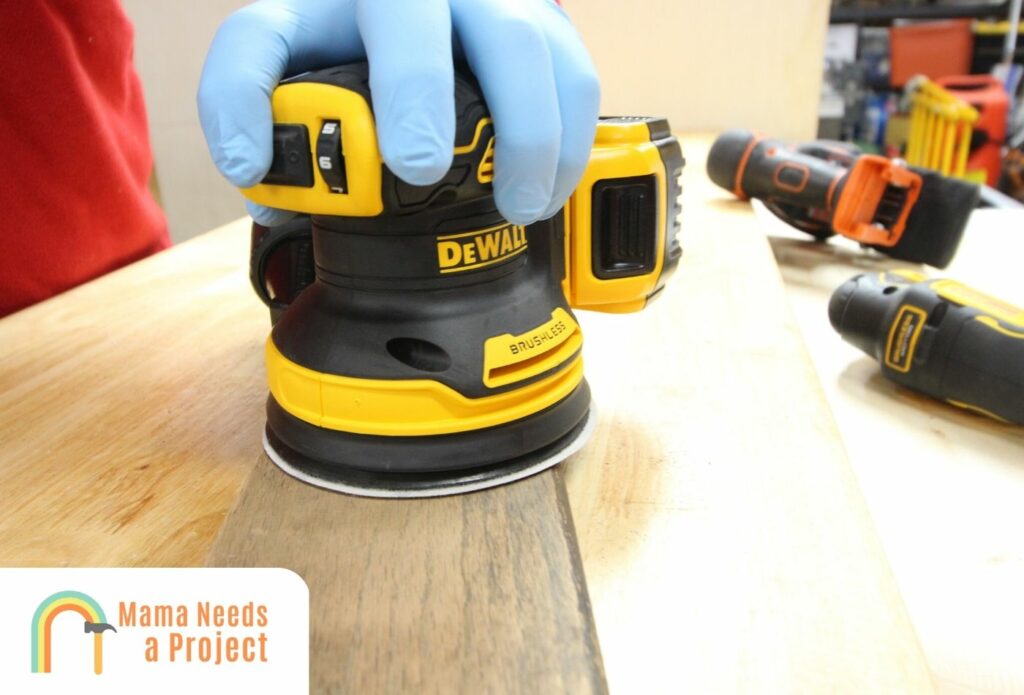
Your first step when preparing a wooden surface for spray paint is sanding the surface.
Sanding is a careful process that allows you to get rid of surface imperfections in the wood, making the surface as smooth as possible.
Sanding wood is important so that the primer (see more below) or the spray paint itself adheres stronger to the surface. It also helps to improve the overall look of your project by creating a smooth texture.
So, how much do you need to sand the surface of wood?
That depends on how rough the surface is.
If you’re working with a natural wooden piece, like something you picked up outdoors, you may need to begin with rough-grit sandpaper (around 80 grit should be fine).
If the surface is largely smooth, or if it only has a few imperfections, fine-grit sandpaper is just right. 100 grit sandpaper could be perfect for your project. In either case, lightly sand at least two passes with your sandpaper over the surface. This should grind down any bumps or imperfections without taking too much time.
You can alternatively use a sanding machine on the surface to expedite the process.
Cleaning the Wood Surface
Your next major step is cleaning the surface.
You should clean the surface in part to remove any of the sanded-down debris or any other leftover residues on the wood.
Fortunately, cleaning wood is very easy.
Simply wipe it down using a piece of cloth or a towel. You may wish to apply a little bit of soapy water.
The primary goal is to ensure that there isn’t any dirt or debris left on the piece before applying either primer or paint.
However, don’t use too much water! If you soak the wood, it may absorb the moisture, which could impact how the paint settles on its surface and what the piece looks like at the end.
Applying a Primer
Now it’s time for arguably the most important step: applying primer.
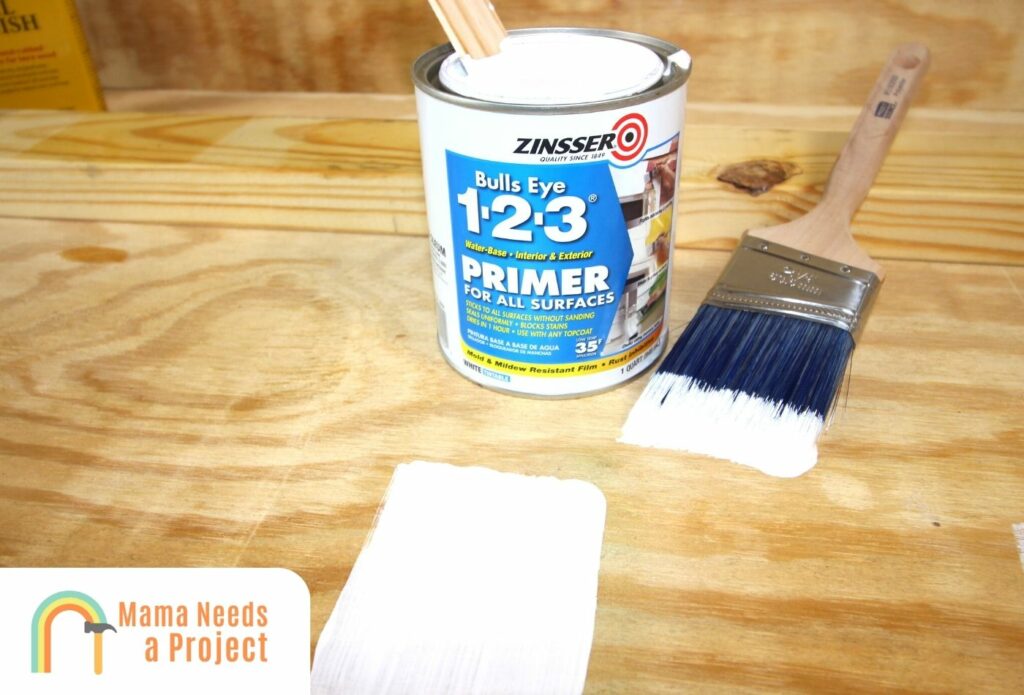
Paint primer is an important substance that seals the painting surface, filling up any cracks, holes, or microscopic imperfections you can’t get rid of otherwise.
If you don’t prime a surface before painting it, any paint you apply could get into those imperfections or cracks, making the end result worse than it would be otherwise.
If your wood is already perfectly smooth, you may not necessarily need to prime it before applying spray paint. That said, most wooden surfaces will need a layer of primer, and it never hurts.
Here’s when you should apply primer.
- You are spray painting natural or rough wood. If the wood feels rough to the touch, apply at least two separate coats of paint primer before applying spray paint. This will ensure the paint job is
- You are spray painting patched or previously repaired wood. Even high-quality wood repair jobs will have various compounds and marks on it that can impact the final finish of the paint.
- You are spray painting wood with stains. If a wood work piece has moisture, grease stains, oil stains, or other residues, you’ll need to apply a stain-blocking, moisture-resistant paint primer.
- You are spray painting any porous wood species. If the wood surface is particularly porous, it will quickly absorb any extra paint you apply. Applying the primer first will prevent your spray paint from being absorbed by the wood so it looks excellent from start to finish. Note that any freshly harvested wood is likely to be very porous, so apply primer in this case as well.
To apply primer, choose a spray primer designed for the project you’re working on. For example, if you’re working with metal, there are special primers designed to work with that surface. Here are some of the best exterior primers you can use.
You can alternatively apply primer using a brush or roller. If you use a brush, use sandpaper to smooth down the primer so it is even after one or two coats.
What if the Wood is Already Painted?
In situations where the wood is already painted, you should try to smooth down the surface of the material using sandpaper before priming it. Removing existing paint with sandpaper can help the new paint coat to better adhere to the surface.
If you’re working with a latex paint, use a paint stripper to remove the paint. If you’re working with an oil-based paint, you’ll need to use a solvent such as mineral spirits.
Can You Spray Paint Wood Without Priming It?
Yes, you can spray paint wood without priming it first, but it’s not recommended unless the work in question is already extremely smooth (i.e., it has no cracks or holes that you can see) or the wood isn’t very porous. Remember, you don’t lose anything from applying primer beforehand and it doesn’t take long to add a layer or two.
Wondering if spray paint is food safe? Check out my guide to learn more!
How to Spray Paint Wood
1. Prep the Piece
Firstly, remember to prep your piece before applying any spray paint.
Check the piece for any cracks, holes, stains, dents, and other surface imperfections. You can use a wood filler to fix any cracks or holes or a paint stripper to remove previously painted surfaces.
Based on these imperfections, you may need to sand down your wood piece before applying any spray paint. Use the appropriate amount of sandpaper until the surface of the piece is perfectly smooth. Clean away any dust or debris the sanding process creates with a rag or vacuum cleaner.
2. Apply Primer
Next, apply paint primer to seal the surface and ensure that the paint won’t get sucked down or absorbed by the wood too easily. Remember, you don’t always need to apply primer, but it’s usually a good idea to make sure you get the best results.
3. Pick Your Paint
Now it’s time to get the appropriate spray paint.
Your two main options are water-based and oil-based spray paints. Water-based spray paint will serve you in the majority of cases, and it’s usually more affordable. Oil-based spray paint, however, is a better choice if your wood surface or work piece is going to spend most of its time outdoors.
For example, if you are spray painting a door that is exposed to the elements, oil-based spray paint is a good idea. If you want to spray paint wood furniture that will spend all of its time indoors, however, use water-based spray paint.
The only exception is if you have an indoor piece of wooden furniture that will be exposed to direct sunlight frequently. In this case, oil-based spray paint could still be the best spray paint to protect the wooden surface from UV radiation and sun damage.
4. Apply the Paint
Now it’s time to apply the spray paint.
To do this, hold the nozzle of your spray paint tool a few inches over the piece. Hold down the nozzle to release the paint, then make long and continuous passes. Release a few inches after the nozzle leaves the piece to prevent the edges from seeming unpainted or unfinished.
To prevent paint from being sprayed everywhere, place the wooden piece over a disposable material like a tarp or paint outdoors. While you can spray paint indoors, it is usually more difficult.
Depending on the quality and type of spray paint you use, you may need to apply several coats of the material. Oil-based spray paint usually requires fewer coats compared to water-based spray paint.
5. Let it Dry
Finally, let your painted wood dry.
Don’t put anything on the wooden surface until the paint is completely dry otherwise you’ll need to apply yet another coat of spray paint to fix the mistake.
It can take anywhere from 2-4 hours for the paint to dry completely depending on the circumstances. If it’s humid outside, for example, it may take longer for the paint to dry.
If you’re in a rush, you can use a hairdryer on the lowest setting to speed up the drying process. Just make sure not to hold the hairdryer too close to the surface or you could cause the paint to blister or peel.
How Long Does Spray Paint Last?
When applied properly, and if you apply a primer layer beforehand, spray paint will last anywhere between six months and five years on wooden surfaces.
That means, you can expect at least a few years of good performance from your spray paint.
If you pick a spray paint that is formulated for wooden surfaces – and if you use a spray paint that is known for its longevity and durability – it could last even longer. But overall, the prep work you do before applying the spray paint will have a greater impact on its longevity than the spray paint itself.
To make your spray paint layer last even longer, use a moisture-resistant top coat. Some spray paint brands offer specialized finishing topcoats that you can apply with your spray gun to make the paint layers last even longer.
How Long Does Spray Paint on Wood Take to Dry?
The length it takes spray paint to dry depends on the type of spray paint you use and the prep work you did beforehand.
If you don’t use a primer, the spray paint might dry more quickly because the wood will absorb the liquid in the paint much more easily.
But overall, spray paint takes between 30 minutes and two hours to dry on most wooden surfaces. You should wait at least 30 minutes in between spray paint coats before applying another coat. But the entire piece will take around 2 to 3 hours to fully dry. Wait at least this long before you touch the wood or you put anything on its surface.
Final Thoughts
If you want to give a piece of furniture a new life, spray painting it with new paint might be the best way to go.
By following a few steps, you can spray paint wood giving it a new beautiful finish. Just make sure to sand the wood beforehand, use a primer, and paint in thin coats.

